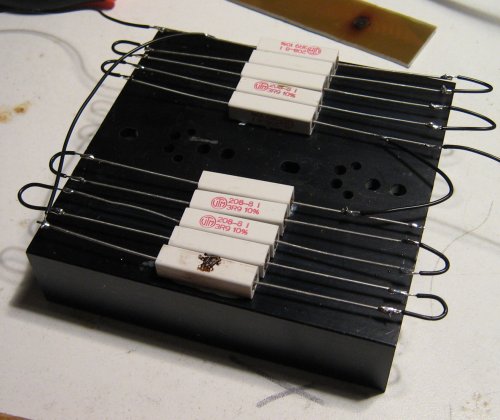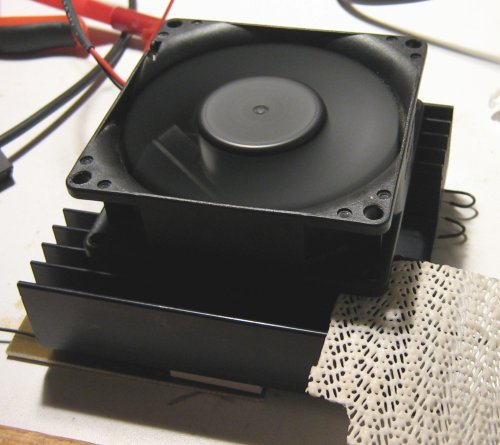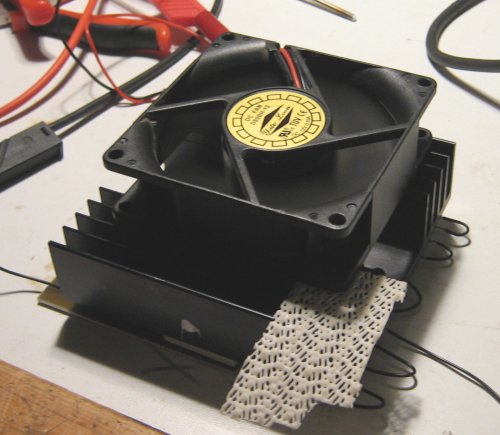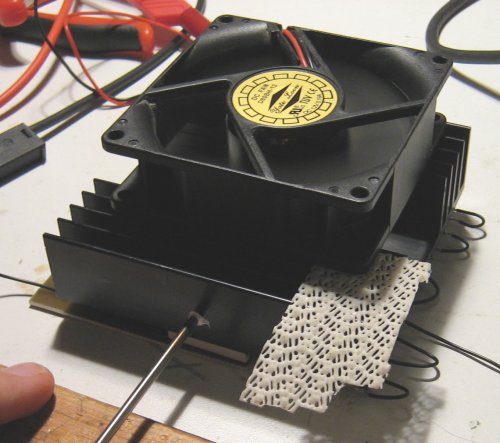Fan cooling: intake or exhaust?
1. Introduction
The direction of airflow is a highly discussed topic on forums and hardware websites. The most commonly held opinion, is that because the amount of air which passes through the cooling fins is the same either way, it should not make a difference. I decided to perform some tests to seperate fact from fiction.
2. Test setup
As a source of heat, I used ten 3.9 Ohm 5 Watt resistors. I wired two banks of five of them in parallel. This gave me 9.75 Ohm with a maximum loading of 50 Watts. The resistors were semi-glued to the heatsink with Arctic Céramique. This thermal paste only liquifies the first time it warms up. When it cools down again, it stays solid, acting as glue. At least, enough for this experiment. It's no subsitute for thermal epoxy.
I determined that I could safely run 10 Watts through each resistor when they were mounted on the heatsink. I therefore had a load which could handle 100 Watts. This was enough heat for my test. The following image shows the heatsink with the resistors attached to them:

Heatsink with resistors.
This is how I cooled the heatsink:

Heatsink with blowing fan.

Heatsink with sucking fan.
I measured the temperature of the heatsink with a thermocouple on the side, with some thermal grease on the tip:

Heatsink with thermocouple.
I put 30V across the resistors, which results in 92.3 Watt (P=V2/R=302/9.75=900/9.75=92.3W). Because I didn't want to cool the heatsink down too much, I ran the fan at 10 V, instead of 12 V.
3. Test results
The following table shows the results of the test. Every measurement was taken after the temperature had stabilized. I didn't let the temperature of the heatsink without fan stabilize, because it was getting to hot for my taste, and I started smelling something burning...
| Room temperature | Fan blow temperature | Fan suck temperature | No fan |
|---|---|---|---|
| 21° C / 70° F | 50° C/ 122° F | 62° C/ 144° F | 90+° C/ 194+° F |
4. Conclusion
The test results speak for themselves: blowing air onto the surface of the heatsink is more effecient. This can be explained when you know that it's the turbulence that matters. If you suck a column of air along the surface of a heatsink, the air molecules
that are not on the outside of the column never touch the heatsink surface. The much more turbulant exhaust of a fan causes much more molecules to come in contact with the surface of the heatsink.
And of course, I can't leave out this magnificant remark by Rod Elliott:
If your spoonful of soup is too hot, do you blow or suck air across the spoon? I rest my case.
